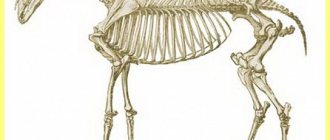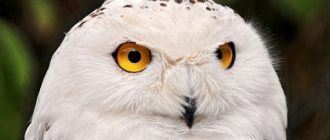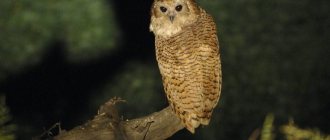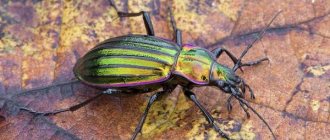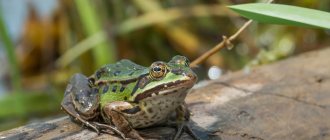Description
Birds of prey have little in common with their daytime relatives, both because of their lifestyle and because of their special anatomical structure. Their skeleton is characterized by a number of unique features, among which the following facts can be highlighted:
- There are small processes on the main bones.
- The third finger is much smaller in size than the others.
- Most varieties have a notch located on the back of the sternum.
- Owls have soft fringes and serrations in their plumage, which allows them to move silently.
Owls have a wide range of species. The sizes of the smallest birds are similar to the size of a sparrow, and the largest predators reach a length of 70 cm. The diversity of habitats also determines the color characteristics, which can be brown, gray, black and white or brown.
Owls are able to turn their heads 270 degrees. This ability is due to expansions in the carotid arteries located close to the lower jaw. Due to this, the number of small blood vessels connected by special bridges increases. They prevent the compression of blood vessels and allow the owl to move its head freely.
Owls are able to position their heads in different ways.
These birds have strong and grasping paws on their legs. Sharp claws help securely hold prey. Their wingspan in flight is about 200 cm. The tail is quite short.
When flying, owls can reach speeds of up to 80 km/h.
Birds have binocular vision, which helps them see the full picture of what is happening in black and white. The lens of the eye is located in the horny tube, which, unlike the standard location in the eyeball, helps the owl to navigate well at night. In addition, the very location of the eyes is on the front part, making it convenient for her to hunt prey.
Owls, unlike people, cannot roll their eyes: they always look only forward. The pupils react not only to light fluctuations, but also to breathing. They are able to expand and contract during inhalation and exhalation.
Owls have excellent hearing, which is four times more sensitive than that of cats. Their outer ear is covered with folds of skin and feathers. The predator easily picks up any rustling sounds, which allows it to quickly detect the presence of prey.
Appearance
Owls have characteristic differences in the form of a facial disc formed from five rows of stiff feathers. Together they form a kind of corolla. The flight feathers have curves at the ends, and also have curves towards the body area.
Regardless of the species, each owl has large eyes that allow it to record any movements of its prey.
Some species of owls have fringes on their outer feathers. The third and fourth feathers are usually slightly longer than the others. Feathers that help steer are located on the tail and are characterized by the presence of a bend that extends to the lower part. The legs of owls are completely covered with highly dense feathers.
Almost all species of owls have rather dull body color, which is explained by their blending with the environment.
The claws of predators are as long and sharp as the beak. The beak itself has a small hook at the end, which allows it to make sounds reminiscent of clicking. The cere in birds is quite short, and its location is covered with feathers.
Interesting Facts
- The cry of an owl is necessary for various purposes. There is an or, somewhat similar to a dialogue that takes place between two males. You can also hear the calling sound during mating games. Baby owls make a similar cry to indicate their location.
- In the old days, owls were very much feared, they were identified with mysticism and were driven out in every possible way.
- But in Egypt, birds were cherished and respected; there were cases when they were mummified.
- Some time ago they found a Babylonian bas-relief depicting owls. There were birds on the sides, and in the center was a woman with wings and paws. People believed that this was a goddess, and the owls were her personal guards. In addition to dark and mystical symbols, these individuals mean wisdom and a bright mind.
- In Christianity, their cry was considered a song of death. Symbolized desolation, loneliness, sorrow. The Slavs considered this bird to be the keeper of underground wealth, also a sign of a widow and a harbinger of fire or death.
Natural habitats
Each species chooses its own habitat, based on the living conditions to which it is accustomed. Owls are found in almost every corner of the globe: in Europe, Africa, Asia, America.
African long-eared owl
Sparrow owls can be found almost everywhere, but this species is not present in Australia.
North and South America are characterized by the presence of owls of the genus “Megascops”, unusual “Fish owls” are common on the Asian continent, “Neotropical owls” have chosen numerous forests in the Central America region as their main habitat. “Striped cutworms” are found primarily in Jamaica, which is how they got their second name, “Jamaican cutworm.”
Far Eastern fish owl
Thus, it will not be difficult to meet representatives of these predators in different places. They are distributed almost everywhere, however, some varieties of owls settle exclusively in a certain territory, without going beyond its borders.
Elena
Ask a Question
Question to the expert
Why do owls fly to cities in large numbers?
Owls can usually be found in cities in winter. Their presence is explained by the fact that in their usual habitats, forests, there is too much snow cover (about a meter), which prevents the owls from obtaining food in the form of small mammals. Because of this, forest species are looking for new places where food will be more available. Usually these are steppes, meadows, fields, but maybe a city. Here, predators catch mice and rats near landfills and garbage containers. They can also hunt pigeons, sparrows and other urban birds. Owls are usually nocturnal, and when in the city, they prefer to stay on tree branches. Because of this, it may seem as if the owl has “lost its way.” However, she knows perfectly well what she is doing and does not need human participation.
Most popular types
- Long-eared owls. They are the most common species in the European part of Russia. The name comes from their ears, which are formed from feathers. Long-eared owls prefer to nest in coniferous forests, which means they are forest birds. Owls living to the south lead a sedentary lifestyle, while the northern ones are migratory birds. They feed on shrews and small rodents.
- Polar. It is the largest species of the owl order in the Arctic. The female weighs three kilograms, and the male two and a half. The wingspan reaches half a meter. Lives in the tundras of North America and Greenland. It can also be found on some islands of the Arctic Ocean. In the natural environment they live up to 8 years.
- Owl. One of the largest species of owls on the planet. They weigh more than three kilograms and live in places where people are practically invisible. They are comfortable in dense forests. According to ancient belief, eagle owl feathers protect against misfortune. In Kazakhstan and Central Asia, people believed that the pattern on the side feather of an eagle owl was a saying from the Koran. The mating season is in March. A person who enters the eagle owl's habitat will be frightened by the hooting of the birds. A married couple makes these sounds, first separately, and then together. Also, this bird has another name - scarecrow. In addition to hooting, his performance ends with loud laughter. They feed on rodents, amphibians, insects and reptiles.
- Fish owl. This bird lives in Primorye, near the Sea of Okhotsk, Sakhalin and Japan. The favorite place for nests is floodplains overgrown with large trees. They feed exclusively on marine inhabitants. And they catch them in two ways: the first is by lying in wait for the victim, not far from the water. The second is to wander through the shallow water and grab the fish swimming by.
Behavior and lifestyle
Recommended by topic
Blackbirds Woodpecker Heron
Despite the centuries-old history of owls living next to people, their way of life is still considered unexplored. Scientists know that predators prefer a sedentary lifestyle, but some species are able to fly from one place to another. In addition, owls prefer to live in pairs, avoiding large flocks.
They can nest in a hollow tree, a rocky ravine, or in underground burrows. Sometimes owls occupy empty, once abandoned nests. They can live freely near a person.
Owl living in a hollow
The ability of owls to live near people gave the birds a bad reputation, since meeting them was considered a dangerous sign. Because of mystical ideas about the reputation of these birds, people tried to drive them away from residential buildings, not allowing them to settle near villages.
At night, owls go out hunting, and during the day they prefer not to come out of their hiding places. At this time, they rest, gaining strength before night activity. During the daytime, owls can only come out of their hiding places when another predator approaches and is about to attack their home.
The exception to the time cycles of activity are snowy owls. Their activity level does not depend on the time of day, which is due to the characteristics of the region of residence.
Question to the expert
Do owls see well during the day?
Despite the fact that owls are considered nocturnal predators, they see quite well during the day. An owl has many other reasons for being active at night, unrelated to vision. The only problem with their visual apparatus can be called some myopia, which does not allow owls to see objects directly next to them.
Diet of owls
Due to the fact that owls live almost everywhere, their diet is very diverse. However, the determining role in its composition is played by the fact that these birds belong to predators, and therefore their diet consists mainly of warm-blooded animals:
- Rat.
- Vole.
- Rabbits.
- Zaitsev.
- Khomyakov.
Polar owls are able to feed on fish, partridges and geese.
However, some species, for example, those that belong to the “Needlepods,” eat insects such as hawk moths or moths. Barn owls and barn owls may feed on rodents and other pests. For this property, the presence of owls is valued by people near whom the birds settle.
Owls are able to remain without water for a long time, since water balance is maintained through the supply of fresh blood secreted by the prey they eat.
In winter, predators make a preliminary supply, leaving mouse carcasses in nests. Hunting during this period takes place mainly on forest edges and clearings.
Owls will never eat carrion. The prey must be fresh or taken from previously made stocks. In the absence of suitable options, the birds will starve until they find suitable food.
What do they eat?
Thus, large and medium-sized individuals eat rats, mice, lemmings, hedgehogs, shrews, hares, frogs, toads, bats, moles, snakes, and chickens. Small owls feed on insects (beetles, grasshoppers), and those who live in coastal areas feast on fish, crabs, and mussels. Those living in tropical latitudes eat fruits, grass, and berries. What is noteworthy is that this bird can go without water for several months; it quenches its thirst with the blood of its prey.
Reproduction and offspring
Being monogamous birds, owls mate once and for life. They jointly care for the offspring, feed the chicks, and obtain food. However, sometimes there are exceptions, characteristic of some species of owls. In these cases, they annually strive to find a new partner.
Reproduction in birds usually occurs once a year. The timing of this period depends on the preparation of the food supply. The female can lay three to ten eggs at a time and incubate them. At this time, the male is engaged in providing food. The incubation period for eggs can take about a month.
Owl eggs appear in the form of a ball, painted white. At the moment of birth, the chicks are completely helpless, even their eyes are still filled with fluff.
Owl hatches eggs
If newborn chicks do not have enough food, stronger chicks may eat weaker ones. Parents take care of the oldest chicks, distributing food in such a way that they get more than others.
Female with chicks
Even after the offspring have become stronger and older, the parents continue to care for the grown chicks.
Family
Owls create married couples once and for all - they are constant in this regard. Short-eared owls may build nests on the ground in dense vegetation. They reproduce once or several times, depending on the environment and living conditions. A clutch can contain from 3 to 10 eggs, which are usually white, spherical and small in size. The eggs themselves are planted by the female, and the male is directly involved in feeding the offspring. An interesting fact is that in most cases only the older chicks survive, while the rest die. When they are hungry, they may eat the last hatched chicks.
Natural enemies of owls
In their natural habitat, owls often die due to lack of suitable food. There are entire hungry years, during which a small number of rodents are born, which serve as the basis of the owl's diet. At such a time, young, still fragile owls quickly die, and their numbers can be reduced by 25%.
In addition, owls are also hunted by other larger birds of prey. Their main opponents are usually:
- Eagles.
- Hawks.
- Golden Eagles.
Many owlets may fall out of the nest on their own or fly away prematurely. Small birds that accidentally fall out of the nest can become prey to other predators such as foxes, ferrets or raccoons.
Fight between an owl and a hawk
In the case of polar owls, Arctic foxes and skuas pose a great danger to their cubs, as they easily attack young birds. Arctic foxes are capable of not only picking up chicks that have left the nest early, but even attacking bird houses, eating eggs and recently hatched cubs.
Humans remain another potentially dangerous enemy for owls. Through the efforts of people, the natural habitats of birds are being destroyed, trees and other plantings that are part of their natural environment are being cut down. People drive birds away from their places of settlement, and sometimes simply exterminate them, believing that they are harmful.
Skeleton structure of an owl
There are two families: the order of owls or real owls, and barn owls. In their anatomical features and plumage, owls are very different from daytime raptors, so ornithologists have brought them into a separate order. The skeletal features of an owl include the following:
- Processes of the main bone.
- Triple connection of the lower jaw with the skull.
- Short phalanges of the third finger.
- Mobility of the outer finger, which bends back.
Population and species status
Owls, being birds of prey, have a great impact on the environment and the processes occurring in it. Through their efforts, populations of insects, rodents, and various pests are controlled. Moreover, some species of owls today are on the verge of extinction due to their constant destruction. These, for example, include the polar owl, which was listed in the Red Book. To preserve its species, a number of conservation measures are being carried out aimed at protecting natural habitats and stimulating the reproduction of polar owls.
All owls contribute greatly to the balance of nature. In addition to controlling the number of rodents and insects, they implement the following functions:
- They hunt sick, non-viable birds, becoming participants in natural selection. This helps cleanse the natural gene pool and breed the most resilient predators adapted to life.
- They distribute fruits and seeds taken from bushes and trees. Thanks to this, there is a massive distribution of material that allows new plant objects to appear, which has a positive effect on the state of nature. This is considered especially useful in those regions where there have been extensive fires that have destroyed large hectares of forest. Birds help replant empty plots.
- The owl droppings produced are considered valuable fertilizer.
Owl - animal or bird, characteristics of the detachment
An owl is a bird, a predator that belongs to the order Owls (Latin name Strigiformes). It is believed that birds similar in description to an owl appeared 10-25 million years ago.
The spotted owl is a bright representative of its family
The order includes more than 200 species of birds belonging to two families:
- barn owls;
- owls (real owls).
Most species are united by a nocturnal lifestyle (with rare exceptions) and a characteristic appearance. Many are found in Russia, for example:
- great gray owl - height 80 cm, inhabits taiga;
- long-eared owl - not large, up to 35 cm, found in coniferous forests;
- little owl - size up to 28 cm, lives in steppes and semi-deserts;
- Great Sparrow Owl – size 15-19 cm, prefers spruce forests;
- white (polar) owl - grows up to 60-65 cm, lives in the Arctic Circle;
- barn owl - size 39-40 cm, inhabits light forests, open plains;
- scops owl (or scops owl) – body length up to 22 cm, found in the mountains;
- eagle owl - height from 60 to 75 cm, lives in any landscape if there is shelter;
- hawk owl - size 35-45 cm, inhabits coniferous and mixed forests.
This is a short list; there are 17 species in the Russian Federation. As you can see, owls live wherever food can be found: in hot regions and permafrost zones, in mountains and forest thickets, in wild areas and near people.
In desert areas, birds nest and hide from the sun among stones
Keeping owls at home
The desire to have an owl as a pet is constantly reinforced by various films, books and TV series in which these birds appear as mystical, mysterious companions of heroes. However, in reality, keeping these birds at home is quite difficult. This is daily work that requires large investments and dedication.
Poll: Do you think it is possible to keep owls as pets?
No, this is unacceptable, as they are wild predators that do not attach themselves to people.
30.77%
It is impossible, because at home it will not be possible to provide them with the conditions in which they live in the wild.
53.85%
It is possible if you try hard and organize a suitable space.
15.38%
Voted: 13
The process of assimilation of an owl into a new space takes quite a long time. The bird requires a large amount of free space, since in the wild it is accustomed to space and scope.
It is worth equipping at least a separate room for the owl, in which it could fly safely.
To do this, it is necessary to install a strong mesh and curtains on the windows that do not let the bird out of the apartment and do not allow it to be distracted by what is happening outside the window. It is best to attach a structure that imitates branches to the walls. It can be made of iron, but it is better for these purposes to take wood, which will be an easily recognizable object for the owl.
Also, owners who want to keep an owl at home need to pay attention to the following features of its keeping:
- Regular flights are an important part of an owl's daily schedule. For her, this is an opportunity for psychological warm-up and physical activity. Therefore, the bird must be constantly released to fly in specially equipped conditions for this.
- Owls do not tolerate loneliness well. If there is a lack of communication, they may begin to make sharp, shrill sounds for a long time.
- When spending time together with a pet, the owner receives many positive emotions. However, such communication also has problems: birds leave scratches and cuts, even when in a good mood. This is due to the excessively long claws adapted for capturing prey.
- The diet of owls at home is practically no different from the diet of predators in the wild. They need food of animal origin: worms, insects, rodents, snakes, fish. It is important that all food offered is fresh, otherwise the owl will starve. For varieties that came from tropical countries, the use of fruits and berries would be optimal.
When owls start eating, they help themselves to cut up prey with sharp talons and beaks. As a result, all the insides fly in different directions, which can quickly dirty the room. Therefore, the owners of such pets should gut the offered food themselves and only after that offer it to the bird.
Cage maintenance is a separate important point in the extensive section of rules for caring for owls. To keep it clean, it is necessary to treat the cage with special products every week. In addition, the owner of the owl will have to take care of removing feathers during the annual molting. He will also have to refresh the water cup daily, ensuring the bird has access to a clean source of drinking.
Genus of long-eared owls
Long-eared owls are divided by ornithologists into 6 species, the unifying feature of which is the long, upward-protruding feathers above the auditory openings.
Long eared owl
The appearance of the long-eared owl speaks for itself - ear tufts of six feathers are clearly visible on its head. Birds measuring 35-37 cm inhabit Eurasia and winter in Africa. They feed on small birds, rodents, and insects. They are not afraid of people and are found in coniferous parks and groves near villages.
Short-eared owl
A close relative of the long-eared owl loves wet lowlands and the outskirts of swamps, where it attacks mice, small birds, frogs, and insects. But the short-eared owl’s “ears” are short and inconspicuous. The short-eared owl lays its eggs in a hole lined with moss.
Area, distribution
Noctuid species have become widespread in Europe and Asia, as well as in Africa and America . Representatives of the Splyushka genus are particularly widespread in Europe. In our country, in addition to Scops Owl, eastern and collared cutworms are also quite common in the Far East, and in Central Asia and Kazakhstan the desert cutworm can be observed.
This is interesting! Sparrow owls are representatives of a variety of biotopes, including taiga, as well as deserts and tropical forest zones, so such individuals inhabit almost all continents of the world, with the exception of Australia.
Representatives of the Megascors genus are inhabitants of North, South and Central America, and Tawny Owls are quite widespread in Europe, North Africa, as well as in Asia and America. Neotropical owls inhabit the forests of South and Central America, and fish owls inhabit exclusively the territory of Asia. Relatively numerous white-faced owls are a fairly widespread African species these days, and Pseudocsors are exclusive to the island of Jamaica.
Return to content
